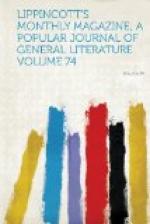L.H.H.
BRIGHAM YOUNG AND MORMONISM.
Brigham Young’s career is a valuable commentary on that of Mohammed, and will hereafter be a standard citation with explorers of the natural history of religions. It might be more proper to go back of Young, and adhere to Joe Smith as the figure-head of the Mormon dispensation. How Smith would have turned out had he lived, and whether he would have made as much of Utah as the man upon whose shoulders his mantle fell, is not easy to say; but his was a less robust character, the enthusiast in him too far obscuring the organizer and commander. The Church is the thing to look at, rather than its leaders, when we consider duration—the soil rather than the plough. Why has Mohammed’s creation lasted longer and spread wider than that of Charlemagne or Tamerlane? And is Smith’s to have the like fortune, or to die out like those of Muenster and Joanna Southcote?
The Mormon “revelation” has been before the world more than forty years. In twenty-two years from his first vision Mohammed had reduced all Arabia under his religious and political sway. Young’s dominions have not expanded territorially. His faith cannot be said to exist outside of Utah. His converts are compelled to go thither for the exercise of their religion. Salt Lake City is not a Mecca, the goal of a passing pilgrimage, but the one and only possible abiding-place of those who profess its creed. A system thus localized is in danger of being stifled. Especially is this the case when its seat is exposed to invasion by a swelling current of non-sympathizers or open enemies. These may be repelled or prevented from improving their foothold by the firmness, unity and numerical predominance of the invaded. So it has happened at Salt Lake. The Mormons hold all the serviceable soil, and it is difficult for the “Gentiles” to effect a lodgment. Until they do, they must occupy, even in their own eyes, somewhat the position of adventurers. They cannot hope to secure the respect of the industrious sectaries who own and till the soil, and who are taught to count them aliens and persecutors. Irrigation is here the only means of successful agriculture. It involves great outlay of capital and labor, and creates great fixedness of tenure. Newcomers are thus additionally discouraged.




